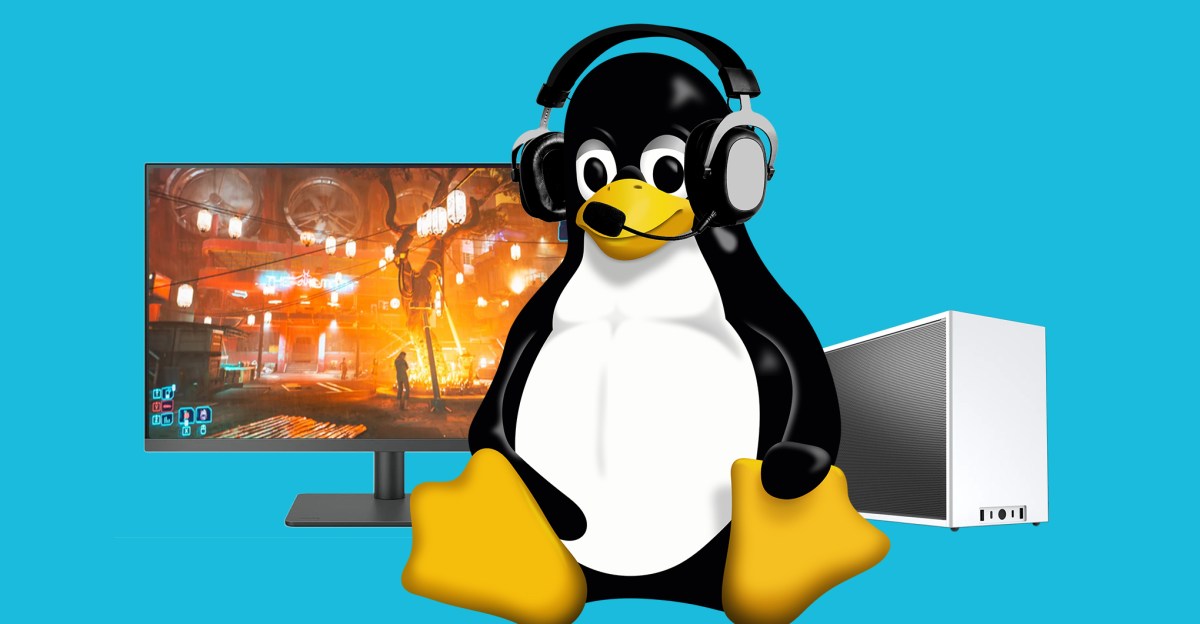What’s the easiest and most secure linux distro for a non-techie? This is for a spare thinkpad I want to try linux on.
Installed Mint last week. I already ported most of my personal stuff there ; as a user of FOSS software, it was a breeze. Still dual booting Windows because of work, but I’ll start trying to see if I can get the required tools to work on there too.
For now, my biggest issue was that connecting my Bluetooth headphones to both Linux and Windows was fucky but, lo and behold, there was a guide online that told me exactly how to make sure both OS had the same device ID.
It’s not a painless experience yet, but it’s way less painful than what it was running Win95 back then. And it feels so good to finally flip Microsoft the bird.
Have you run into the system clock issue yet?
🤞pleasejustpickbazzite pleasejustpickbazzite pleasejustpickbazzite🤞
I’m going to install CachyOS, an Arch-based distro
oh god dammit
CachyOS has been flawless on my S/O’s desktop. From an easy install to plenty of documentation available, I couldn’t have asked for much more. During install, there’s an entire step dedicated to checking a box if you want to play games. (To enable non-free drivers).
I don’t think it was a poor choice.
Flawless wouldn’t require any documentation.
They didn’t say it required documentation, they said it had plenty of documentation should you need it.
I’M FED UP, GOING TO INSTALL LINUX!
- picks a complicated distro where you really need to read the manual or do some heavy google searches to do gaming *
I’M FED UP, THIS IS TOO HARD, I’M GOING BACK TO WINDOWS!
Every. Single. Time.
If you want to use arch for the first time use an already setup distro like Manjaro.
I disagree. If you want to use Arch for the first time, install it the Arch way. It’s going to be hard, and that’s the point. Arch will need manual intervention at some point, and you’ll be expected to fix it.
If you use something like Manjaro or CachyOS, you’ll look up commands online and maybe it’ll work, but it might not. There’s a decent chance you’ll break something, and you’ll get mad.
Arch expects you to take responsibility for your system, and going through the official install process shows you can do that. Once you get through that once, go ahead and use an installer or fork. You know where to find documentation when something inevitably breaks, so you’re good to go.
If you’re unwilling to do the Arch install process but still want a rolling release, consider OpenSUSE Tumbleweed. It’s the trunk for several projects, some of them commercial, so you’re getting a lot of professional eyeballs on it. There’s a test suite any change needs to pass, and I’ve seen plenty of cases where they hold off on a change because a test fails. And when it does fail (and it probably will), you just
snapper rollbackand wait a few days. The community isn’t as big as other distros, so I don’t recommend it for a first distro, but they’re also not nearly as impatient as Arch forums.Arch is a great distro, I used it for a few years without any major issues, but I did need to intervene several times. I’ve been on Tumbleweed about as long and I’ve only had to
snapper rollbacka few times, and that was the extent of the intervention.Yeah, there are many people that just want the system to work and not have to become full time geeks like some of us are. There are also plenty of distros, atomic or not, that provide that experience. Perfect match. There’s a distro for everyone, from anti-tech people to full blown rocket scientists.
Honestly, Day 1’ers, I’d rather they run Debian, Mint, Ubuntu, or Fedora. There are strong communities that are noob friendly. Go ahead and install Steam, get some games working, get their feet wet. 99% of the time, they don’t need more than basic stuff. Once they’re over being afraid of not being in windows, then start distro hopping to whatever they want.
KDE Neon ftw
I can really suggest Mint for beginners simply because it has an UI for about everything you need somewhat regularly. This means, that you can use GUIs to get familiar and aren’t forced to know your way around the terminal. Its the Ideal beginner Distros (at least from my experience)
If you going to install Linux, install something basic like Ubuntu, fedora, mint and pop is!
Now tons of people will start searching for cachyos, because the vegre did.Nothing wrong with Arch as a distro base. The meme stuff is all bullshit. It is a peer of Debian and Fedora. These foundational community distros are not a good starting point for a beginner or for a painless consumerist experience but they are solid for experienced users and have the best support and documentation.
If you are approaching Linux from the PoV of someone who wants to learn rather than someone who wants a reliable consumer computing platform the big community distros are still absolutely the right way to go IMO.
People go on about Mint being friendly for users but under the surface it is Ubuntu which itself is pulling from Debian. People laud Bazzite despite it being Fedora based. ChromeOS is shipping Gentoo to school children. If you package Arch well and ship it to people like Valve has its an extremely pleasant consumer platform. CachyOS improves the arch installation and micro-optimises FPS but you can screw it up as easily as any other mutable Linux system so fundamentally it is not much better or worse than Mint or Ubuntu or Fedora for a consumer experience.
SteamOS, Bazzite and ChromeOS all recognise that immutability is the key to a reliable experience for consumers - an experience that surpasses Windows. Updates are the most likely way to break a system and the hardest thing for non expert users to troubleshoot and rectify. Immutable distros with good support for new hardware have to be the S tier choice for Windows refuges. I have never tried Bazzite and likely never will (I use arch btw, with one system being a cachyos hybrid) but on paper it seems like the most sane choice barring a general release of StreamOS. A distro like Mint might be user friendly but it is bringing nothing new to the table when it comes to a reliable experience for consumers.
The real solution for the majority of WIndows refuges is going to be pre-installs with the supplier guaranteeing all the hardware is supported like Steam Machine. That way you get rid of all the cursed Nvidia systems. I think something like PopOS is the wrong way to do it for normies as the old LTT videos demonstrated, it is still a fragile system for naive users underneath the friendly skin.
I’m an experienced Linux user, I put Bazzite on my old machine that I’m using as an HTPC.
It’s imperfect. The install process is quite brittle, especially if you’re doing something as mundane as “I want the OS on this SSD and my home folder on that SSD”.
Idk I like that it has its own dedicated wiki instead of hopping forums all the time. And recompiling deb to work in your system isn’t that hard, somene might have already done the work for you in aur.
Come on in a few weeks? I thought it’d be the whole process and not just the planning stages…
When will it be the year of actually being able to read articles?
Linux has been great for me for over 20 years, but the damn internet continues to get worse.
The most successful Linux distros are ones that normal people are not aware they use at all. Most people dont install operating systems, they just use whatever comes with the device. To them its an appliance.
Android is a flavor of Linux and is widely successful. Ive seen libraries use Linux and a browser and the machines worked for decades. And there are quite a few Amazon tablets, ebook readers, etc… all using linux.
Theres a never ending number of examples out there.
Are you suggesting we should break into people’s homes and discreetly install Linux on their computers? Because I’m in

I think we need a new worm
I’ll leave my door open today. Please make it work and let me play games on steam without having to learn.
Seriously, I’m almost ready to try.
Sounds fun!
🤣 Thats pretty funny.
I’m not going to dwell on how annoying it is that it took people THIS LONG to get off the Windows train. I’m just happy to see the world changing for the better.
Welcome to civilization, new Linux users!
Probably due to gaming. Its amazing I can get adult foreign novel games to work on Linux through proton. It just works nowadays when back in the day, you had to tinker with wine and winetricks for so long. That was the last hurdle for me to overcome the barrier of using Linux.
It was for me as well. Proton has been mostly there for years. I’m about to hit year 4 of gaming only on Linux.
I think the last hold out is kernel-level anti-cheat. Hoping it just goes away and consumers stop supporting it. One can dream.
Oh man, don’t read the comments, sad to see the smartasses saying “report back when you install windows again in two months” while getting utterly fucked by Windows.
I mean, I understand being resistant to change but being a fanatic of Windows or anything for that matter just because that’s all you know is really ignorant, it’s not a sports team for fucks sake, of course it’s not easy switching and you will have problems just dont be afraid to ask and read the error warning.
Rant over
I use Windows for work and I miss Win10, I don’t like it but I’m aware that’s currently the target of most Consumer SW for good reason but that reason is starting to break (say it with me! BAD BUSINESS DECISIONS!!!).
Happy to see Linux getting mainstream, not all comments are bad but I the trolls got me.
It’s like do-gooder derogation. ( https://en.wikipedia.org/wiki/Do-gooder_derogation )
Someone doing something good? Fuck them. They think they’re better than us?? Where do they get off??!?
A lot of people are trash and are emotionally invested in both the way things currently are, and that they are a very good person
TIL there’s a name for this
There’s a name for everything. There’s probably a name for there being a name for everything.
I’ve been using Linux as my daily driver for over a month. The only thing I miss are some old windows apps that I’m too lazy to troubleshoot in Wine.
I’m too lazy to troubleshoot in Wine.
I’ve been daily driving Linux for about 3 years now and one major tip I can give is to avoid using non Linux apps as far as possible. When I started with Linux I also tried to get windows apps running on Linux, but this, at least as far as I remember, never worked the way I wanted ans always caused more troubles. Currently I’m at a point where I dont even know when I used plain wine (I am not counting proton) the last time. It has been 2 years at least. I Am using native Linux apps for everything I do. Much less trouble shooting, no need to learn wine additionally to the command line and much less prone to breaking because of an update.
What if you run windows apps through proton
This is the right approach but IF you must and IF you have decent computer, try Winboat
Well, if you honestly think about it, Linux has always been tried by many of people that eventually went back to Windows because something wasn’t entirely straightforward. Don’t get me wrong, I love Linux, but I don’t blame people for thinking that. Trying Linux is very different than sticking to it. Linux is amazing OS for people who put at least some effort into learning it, but like it or not, it can be absolute pain for those expecting things to just work without any interest on why they experiencing issues. Given how many sets of hardware and peripherals people have, weird quirks, bugs and required workarounds aren’t unheard of. Maybe it’s just something very simple to fix for an advanced user, but normies will just run away.
it can be absolute pain for those expecting things to just work
Linux Mint just worked.
it can be absolute pain for those expecting things to just work without any interest on why they experiencing issues.
I think that describes computers.
Windows does the same thing, only worse because it is harder to trouble shoot, and harder to fix if you find yourself at the point where a reinstall is the only way out.
I am dealing with a laptop like that now for someone else, and it would be simple if it was linux, but of course its a pain in the ass because its windows.
As someone who tried it for a few months then switched back for several years before returning permanently two years ago: Linux has long had the problem that it’s completely ready for different people at different times.
In 2017 it was in pretty good shape if you weren’t a gamer, didn’t mind tinkering a fair bit, were prepared to learn a completely different two ways of installing software, and didn’t rely on proprietary apps (I couldn’t get Netflix to work). I was only ready for the tinkering. Also I’d used Ubuntu and gnome just added more changes.
Five years later a lot had changed. I wasn’t using Netflix (especially not in the app) for one. But Proton had come around and made gaming just work. My wifi drivers just worked unlike before. Years of mobile app stores and a few months of lemmy had prepared me for repos, even though it still took some getting the hang of to switch from just downloading and double clicking an exe file. But also the software options are increasingly available rather than having to learn to use old school wine while in the middle of a massive change. I still think I should switch away from garuda at some point as I dislike some of the choices it made (no flatpak support for one), but I love aspects of it. And all throughout that time that Linux was getting more accessible to someone like me who isn’t a coder, but was tech nerd curious, windows was increasingly getting in my way and becoming anti user.
I think adoption will continue to increase as Linux continues to get easier for more people
Garuda was a great distro for a hot minute. It was right where it needed to be to access Steam on Linux right as the Steam Deck came to market. It got all the performance benefits of Proton immediately as other distros had to play catch-up.
It still is a great distro, but it’s lost some is that exclusivity.
it can be absolute pain for those expecting things to just work
Which is like 95% of people.
Imagine if cars worked this way. Imagine you needed to be a mechanic to operate your vehicle. To start and drive your car, you first have to do automotive work, and know how to do automotive work.
A lot less people would drive themselves. A lot more Ubers.
Wait what? Hahaha, it is only a problem when things don’t work. Same with cars, as in your analogy, if your car is not starting your are taking that Uber…
You don’t need to be a mechanic, but you need to know the lights in your panel, know how to check the oil, know how to change a tire, etc… For when things go wrong and maybe you can repair what’s needed yourself.
Bringing it back to Linux, you can try Linux directly from a USB without installing anything and most of the time it just works. If gradma is only reading the news or watching youtube she doesn’t care what OS it is.
I don’t see them as trolls. I’ve been on ZorinOS for about a year now. I hate it because I don’t know how to do anything, but I’m not smart enough to learn terminal.
Flatpaks are the answer to installation. But any problem I have, I google, and every result starts the same way.
"Ok, Step 1, open terminal
NOOOOOOOOOOOO!!!
I have a 100% rate of those solutions not working for me. And the reason is simple. Those solutions assume you know how to use linux. So when you copy and paste their terminal commands, and your terminal responds with error: dependancies not found, YOU know how to fix that error and it works for you. But for most regular people, thats the end of that. Problem not solved. Problem remains a problem FOREVER.
No, seriously. I have a usb recovery stick that allows me to backup/restore my hard drive exactly how it is. Anytime I have to use terminal I ALWAYS make a backup of my hard drive first. Which takes 4 hours. And the reason for that is, when I inevitably fuck something up in terminal, and the whole OS crashes, and refuses to boot, I have a backup. It takes nearly 20 hours to restore the image, but it works. But whatever problem I was trying to solve remains.
Imagine if that were your linux experience. Windows spies on you. They have enshitification out the ass. But it works for the masses without technical knowledge.
The other issue is that businesses use windows. So most people are firmiliar with windows. So all the popular programs are on windows. Linux has a way to emulate windows programs, but its hard to get working, and sometimes just DOESN’T work.
If linux had every single program windows has, 100% as a flatpak, it would do wonders for install rate…for about a year.
Once people install the programs, they’ll at some point run into an issue. On windows you solve the problem 99% of the time by restarting. On linux, that hasn’t fixed any of my problems once.
These people aren’t trolls. They just have a different opinion than you from a different perspective.
Next time you have an issue in linux, any issue, regardless of how small, I want you to turn off your computer for 4 hours. Then turn it back on for 5 minutes. Then off again for 20 hours. Don’t solve the issue. I know YOU can solve the issue in 30 seconds, but don’t. After the 24 hours no computer use, just live with the problem for the rest of your life.
Yeah, that doesn’t sound fun, does it? Sounds like a reason to have a sour experience. Suddenly they don’t seem like trolls.
By the way you write I now you are smart enough to learn the terminal and you should not fear it, since you are starting with linux it is expected that you will make errors and that is ok. Linux is yours to do and undo.
One of the reasons why Mac was able to take some market share from Windows is that all their computers are the same regardless of the needs of the user, so trouble shooting is easy as all are the same.
Your full backup strategy is kinda overkill, also tells me your are more than capable of learning the terminal btw, you should just back up the critical data then reinstalling/fixing your installation will take the same amount of time for backing your full drive. There are forums to ask for help in linux and there are a lot of us that try to help brother/sister in need. Also timeshift might be easier faster than the usb thing.
I do not know Zorin OS but there are other flavors of Linux that might be better for you, maybe something atomic like Bazzite which is immutable so you can’t fuck it up. One distro does not represent all.
About your Windows for the masses comment, every one of us linux users started with Windows because that’s what the computers came with, Microsoft paid a lot for that to happen, and the users got used to Windows and got used to its quirks. That is in itself technical knowledge, so there are no computer users “without technical knowledge”
About the restarting the computer to solve issues comment. That’s just not true, my work Windows computer started blue screening with no reason, no amount of restarting fixed that.
Now to the trolls, they are trolls, your are giving a proper argument for your use case and I respect you for that because you are giving linux a try. The trolls im referring to are the ones shitting on linux without even trying it or just calling people names because they dare to try something different.
About your comment for living with issues with my setup forever as a non-techy user reminded me of the 10s of toolbars my aunt had in her computer and complained when I removed them because she had gotten so used to them.
Do not fear the terminal even Windows was once DOS, install and try all the distros you can they are FREE, there are a lot of flavors for different needs.
I hate it because I don’t know how to do anything
Some examples of what you’ve been unable to accomplish might add clarity.
but I’m not smart enough to learn terminal
Bull. Shit. You’re just not used to it and, even without picking up any knowledge of shell scripting, you’re only a
man somecommandaway from understanding what specific command line programs do.somecommand --flag --another-flag /home/me/thingtypically isn’t much different from opening some GUI app on Windows, ticking two boxes, opening the file picker and selectingC:\users\me\thingthen clicking a button.All that said, now we really need examples because there’s probably no need for you to be messing with the terminal to begin with. At least not if you aren’t doing anything outside basic computing like web browsing, chat, productivity tasks and such. So what are you trying to do in the terminal that the OS failed to provide a GUI for?
Flatpaks… NOOOOO…
I haven’t used Zorin but flatpaks are enabled by default if I understand. Yes, you can install them via the command line but it looks like you could just open the built in software center and search for whatever it is you want. The only exception I can imagine is if you’re trying to install from a source other than whatever Zorin uses by default (Flathub, I would guess).
dependencies not found
With Flatpaks? Wat? With some other command? Context, please.
Anytime I have to use terminal I ALWAYS make a backup
You’re competent enough to image and restore your drive but not stay out of trouble in your OS? You presumably had to learn whatever software, and the underlying concepts, you’re using for that. Clonezilla, Rescuezilla, Macrium Reflect, etc all exist to make it easier but you’ve gotta know what an “image” is, what it means create it and subsequently write it onto a drive. How to identify the correct drive so you’re not wiping out something unintentionally.
So, are you not spending even a few minutes to check if the code snippets you’re pasting are applicable to your specific distribution? At least skimming the
manpage for the commands you try to run? Are you assuming “it’s all just Linux, right?” and that there isn’t nuance between distributions? Running shell commands you don’t understand is like running whatever backup solution you’re using without understanding it - just blindly clicking buttons and maybe you get a backup or maybe you format a drive and lose decades of family photos, your research paper draft, and whatever else. And if a fuckup costs me a literal day of my life in restoration time, I’m making it a point to use that time to figure out why so I hopefully don’t repeat the process in the future.There’s little substance in your complaints and I’m left just so genuinely confused. In my head I’m imagining a walking talking XY Problem. Some specific examples of what you were trying to achieve or the snippets you were blindly pasting might shed some light but, left to guess, your actions sound akin to gamer kids running random batch scripts claiming to tweak power settings or whatever else in order to eke out a few extra FPS. Windows isn’t going to protect anyone who treats it the same way you have seemingly treated Linux.
Can’t speak for you, but trouble shooting, even if you dont know what you do, is at least in my experience way easier. A terminal command does the exact same thing, no matter on which system (OK, there are differences like package manager, but you get what mean) and no matter when. On Windows you get 10 screenshots of a UI that has changed 10 times since the creation of the guide and no or a completely useless error message if something does not work. As long as you are not trying to debug big ass problems that affect core components of your system (bootloader, drives, stuff with the kernel) it is in fact quite hard to fuck up your entire system (it can happen with Updates on Arch, but this is usually quite rare). As long as you are not touching anything else except your /home directory you should not be able to break your entire system. Also if you are still scared of losing date, there are ways of creating system snapshots (backups). Backing up your home directory is enough because this means, that all the files you use daily are backed up.
Since you mentioned dependencies, here’s a quick answer to what this means. There are a shit ton of programming libraries. A library has the use case, that a developer does not have to reinvent the wheel every time they want to do something. You dont want to write a complete library for GUIs every time, but instead use standardised well maintained and documented libraries. Since Programms use these they depend on the user having this library (or alternatively Programms) installed. This is called a dependency. In most cases dependency errors mean, that an expected library is not installed. In this case simply copy the name, and search “install name Linux (or your Distros)” and you are almost guaranteed to find a tutorial for installing it.
My best tip is, that you take the time to learn the basics of Linux. What is a package manager and which one does my system use, how do I navigate directories, how do I create and delete files, how do I edit files. How do I copy or move files. If you know the basics of these things you know most of the stuff you need to know to understand what you are doing. If you want to read more about a specific command you can also always refer to the man page of said command. For this simply type in man “command name” (e.G. “man cd” this gives you the basic infos about the CD command (used for navigating directorys))
You can learn how to use the terminal. You have demonstrated the ability to compose a coherent sentence, you can learn.
Every terminal command is a program. Typing a “command” into the terminal is just typing the name of a program. If you type
firefox, Firefox launches. If it’s installed, we’ll come back to that. Anything else in the “command” like if you see letters or words after a dash, something likels -ais an option, it’s like ticking a box in a dialog window, but on the front end. I recommend spinning up a virtual machine or getting a Raspberry Pi or something you don’t care about, and following some tutorials. Learn how to move around the file system, install software, run some utilities.About that “if it’s installed” part. You mentioned you run Zorin. Zorin is what I call a Trendy Distro Of The Month. I’ve been using Linux for twelve years now, this hasn’t stopped yet. There’s the mainstays like Debian, Ubuntu, Mint, Red Hat, Fedora, Arch, OpenSuSe, there’s the niche special purpose things like Kali and TAILS and Puppy and Tiny, and then there’s the hundreds of quadrillions of “We took Ubuntu, put Steam on it by default, swapped SystemD for whatever.rs, swapped Firefox for Chromium and did a half-assed job at theming and extending Gnome that’s going to break every time they push an update.”
PeppermintOS, ZorinOS, ElementaryOS, Pop!_OS, Garuda, Nobara, Endeavor, Manjaro, Bazzite, Cachy, hundreds of others, are basically the same software in some slightly mutated permutation that most veterans aren’t familiar with. Invariably the veterans first hear about them from noobs who went looking for a distro that is “good for gaming” or “easy for beginners” and because SEO they find the Trendy Distro Of The Month. Which always offers some little gimmick that ultimately doesn’t matter. The process of getting a Bazzite ISO is taking a little Cosmo quiz about what you’re going to do, but then the installer is really borked compared to Mint or even Fedora.
A lot of instructions are written with Ubuntu or sometimes Fedora in mind, and then you pick a distro that differs from those, and then bitch that instructions don’t work.
Also, you need to upgrade your backup hardware if it takes 20 hours to image a drive. That should take minutes.
I mean, I understand being resistant to change but being a fanatic of Windows or anything for that matter just because that’s all you know is really ignorant
I’m suspecting around 80% of the people who switched to Linux after Win11/AI stuff, will switch back within 6 months.
I’m saying this as a Linux user.
Yes and that’s ok, but the comment you tagged is about the people just shitting on linux without even trying it, they are kind of Windows hooligans.
I’m still going strong two years later! :D
The top comments don’t look too bad now… Maybe they’re ranked differently or something
Who knows, maybe Autodesk will finally start thinking about Linux.
They already use Qt anyway, so the .NET part is all they’d need to fix.There’s Mono. I don’t know what portion of .NET compatibility issues that addresses in 2025.
Well of course, there’s probably other Windows stuff they are also using, considering how much they aren’t even trying to ship for something like Ubuntu, which would be super easy otherwise.
I can only imagine how big of a push Autodesk can easily put towards Linux. That would easily make the current rise to 5% be nothing in comparison. Maybe MS is paying them too, to keep them together.
Of course it might also just be that MS makes it easier for them to setup a DRM (Digital Rights Management) as compared to Linux, not that it matters considering how much they have been pirated.
Then there was this person who was not using Linux because of the CAD software he wanted to use and when I asked what exactly it was, he said, “KiCad”[1].
it’s available in Arch and Debian official repositories ↩︎
The existence of PC Master Race tells me everything I need to know about gamers who cling to windows. Edit: And post comments like the “report back” one you cited.
“…Based on listening to two and a half episodes of Dual Boot Diaries and a brief text conversation with Will, I’m going to install CachyOS, an Arch-based distro optimized for gaming on modern hardware, with support for cutting-edge CPUs and GPUs and an allegedly easy setup…”
One of the most important lessons I learned from using Linux: Follow the packs, use the distros that a lot of people use not just some recommendation on some ranking sites / youtube vids. Ffs, might as well use vanilla Arch at that point so you can find answers faster. . Even Mint or Ubuntu LTS is a solid option.
The problem with new distros is that it is very hard to find answers to problems. General questions? Sure you can find help. Some bugs that mess up your system? You better pray to the GNU Gods that your distro spins are not that different from the original, e.g. Regolith’s i3wm vs normal i3wm…
Bingo. Self hosting is my first exposure to Linux, I’m still a novice. Just migrated a couple of my Pi servers onto a Beelink EQ14. After a bit of reading i decided to install Ubuntu server on it purely because I’m more likely to glean answers from online forums & the like when inevitability hit a barrier.
I’m highly likely to dual boot my laptop/switch to linux Mint soon too
Arch is a… Wait, let me rephrase: an Arch-based distro that leads the user by the hand when it comes to setting up the difficult stuff is a good choice, if only because of the Arch Wiki being the golden standard in terms of user-friendly documentation.
I’m surprised to hear that about the docs. I would have assumed it was very technical and assumed a lot of domain knowledge. Based on the Arch memes.
Great to hear!
The wiki can be rough at some times, but you are guaranteed to learn a shit ton about Linux Ehen reading it. It gives you the commands you have to copy/paste most of the time, so its not to bad.
I feel like Arch memes come from the fact that Arch - by default - doesn’t offer any fully fledged installer. You kind of build it yourself and configure everything manually. It’s something that’s become more tedious than difficult thanks to the amazing Wiki, which describes every step of the way.
There’s still a bunch of hilarious “Arch Greybeards” going “ah, you used archinstall, so can you truly say you installed Arch” but otherwise a lot of users are not that technical.
But, yeah, I decided to switch to something Arch-based because, like, 80% of the issues I had with Kubuntu/TuxedoOS eventually ended with someone linking an Arch Wiki article.
You’ll have to decide how user friendly the archwiki docs are for yourself. I find most of it pretty useful but sometimes it can get techy, or get confusing about versions/updates for llatest changes and so on.
It’s probably better than any other linux dox in my opinion. But that bar is not exactly high.
Then again I don’t know if windows even has documentation at all - I assume they replaced it with coprolite.
Mainstream : 3% lol
BREAKING: Man decides to install Linux.
More details to come.
I am glad to see articles like this. For too long I have seen articles saying “sick of this windows bullshit??” Only to find advice on workarounds in windows, or suggestions to use a console, or a fucking phone app. For too long Linux has been treated like the evil twin locked in the attic, never to be spoken of or acknowledged.
IT IS TIME! TIME TO ANNOUNCE WE HAVE RELEASED THE LINUX AND IT WAS THE GOOD CHILD ALL ALONG! BART WAS THE EVIL ONE AFTER ALL! LET IT BE KNOWN!
“I deleted the recycling bin folder named /bin/ and it just froze what do I do?”
Freeze? Nah, it’ll keep chugging along 'til you reboot (or otherwise try to run a new program), and then won’t be able to start.
BREAKING: Man breaks Linux, installs another distro, and lives happily ever after.
That’s like eating exactly one potato chip.
LOL, I’ve actually tried Ubuntu, Fedora, OpenSUSE, Puppy Linux, DSL, Tiny Core, and even the true outlier (not quite Linux or Unix though) Microsoft Xenix before. I’ve probably even tried a couple other distros before but only very briefly.
It takes effort to break them in any way that I can’t manage to figure out how to fix.
I settled on Linux Mint as my daily runner, but one of these days I might have to give TempleOS a spin in a virtual machine…
Try an atomic distro too, if you haven’t yet. It’s a completely different experience from regular Linux - specially the ones that take care of everything for you like UBlue’s.
As a chaos monkey, I haven’t broken this atomic distro in a few years. It usually takes me less than a year to break my distro’s package system beyond my comprehension (or something equally important, but it’s usually the packages).
Are there instructions for the laymen? How difficult is it to install and actually use it?
People have given you good resources, so I’ll just speak to the second part: I switched a few months ago, and it has been surprisingly easy. I’m just… doing normal computer things like I used to on windows. Even gaming.
Easier than windows. Most people don’t actually install that, though. It’s just there when they buy their computer.
Honestly, the most complicated part is getting the install media ready to go.
Once the installer starts, you’re just answering prompts like the local username and password you want, language and keyboard layout, and time zone, and it does the rest on its own.
Then the computer reboots, and you end up on the desktop of a fully usable computer. Most distros will have a one-time popup welcoming you and maybe leading you to some Flatpak “store” where you can search for free apps to install.
- Download the .iso file of your favorite distro from their website
- Download Fedora Media Writer
- Plug in external media (flash/thumb drive, etc.)
- Select .iso and thumb drive in Fedora Media Writer and let her rip.
- Restart PC.
- While PC is booting, press whatever your BIOS button is (do a web search for “[laptop/motherboard] BIOS button” or watch the display while booting)
- Look for boot priority in the BIOS and set the thumb drive to the highest.
- Restart
- After booting, test WiFi, BT and audio functionality.
- Follow on-screen instructions to install
- Remove install media and reboot
- Install any and all available updates using your package manager (Software, Discover, Pop Shop, etc.)
- Restart one more time
The end.
You need to backup any data you want to keep to another drive before installing.
Make sure there’s nothing important on the flash drive too. Writing the iso will erase everything on it.
After booting, test WiFi, BT and audio functionality.
This is an important step. One time I boldly just installed without testing anything in the live session, and discovered that HDMI and Ethernet didn’t work. Woops.
Yikes. Did you at least have a working display port or something?
Yeah, display port worked fine. It was when I plugged the second monitor in to HDMI I realized the problem. And then couldn’t get online to search for issues.
I had to tether the desktop to my phone over USB to get a network connection.
I later installed pop!_os , tested all that stuff, and it worked out of the box.
Download Fedora Media Writer
I’ve been using Balena Etcher, but now I have an alternative, thanks!
Yeah, everyone seems to use Balena. They had some controversy a while back. I don’t remember what it was, just that I found an alternative. FMW has the benefit of drop-down for official distros and it’s available on all platforms (unlike Rufus).
Balena started collecting telemetry without disclosing it to anyone, reportedly including information about what images you were flashing. Apart from a general distaste for unconsensual telemetry, I think people were concerned the data could be used for things like helping to de-anonymize TAILS users.
Remember to do this on a machine you don’t care about, or are prepared for Windows to no longer work. Windows doesn’t play nice with other operating systems.
https://www.zdnet.com/article/you-can-try-linux-without-ditching-windows-first-heres-how/
Play with this first if you want
One could try a Live version for the distros that have that feature. For those unaware, the Live version is merely the bootable cd image (or USB image). Does no harm to the underlying OS. If you like it you can then install it.
Edit to add: If you use bitlocker (copy your keys), it can have hooks in the TPM/bios settings as well. Disable bitlocker prior to attempting a live boot.
https://www.linuxliteos.com/forums/showthread.php?tid=9145
Beware of BitLocker though - I had no idea it was enabled on my wife’s windows tablet and when I came back from a Linux live image her windows drive was locked. The keys were not in her Microsoft account and we couldn’t find them anywhere else so I ended up having to erase the device. Luckily she didn’t use it for much but find and copy your keys before attempting a live Linux boot.
Good to know and thanks for mentioning it, but it is odd that this happens if nothing is done to the host’s hardware. Did you ever discover the why of it?
find and copy your keys
A good piece of advice regardless of what one is doing. This isn’t the first time I’ve heard that keys weren’t found in someone’s account.
Edit to add: It appears bitlocker has hooks in the TPM/bios settings as well. Disable bitlocker prior to attempting a live boot.
https://www.linuxliteos.com/forums/showthread.php?tid=9145
You act like the everyday user knows how to boot from alternate sources.
BIOS/UEFI/Secure Boot anyone?
Edit: I’ve been running Linux since 2011, but I’m not an average everyday user.
Doing one you actually use helps you commit
But always back up data or swap ssds
Yeah. Get a new ssd for the install is a good idea
Windows generally works fine alongside Linux, but then randomly one day you could log on and it boots straight into Windows and to fix it you need to learn the “fun” task of fixing your system with arch-chroot.
That will never happen if the default boot is into GRUB
If Windows overwrites your EFI partition then you won’t be able to boot into grub. It absolutely happens, I’ve had it happen with my main computer within the past year.
It’s pretty much just like installing Windows, except minus the parts where they force you to create a Microsoft account and badger you to accept spying and such.
It’s often easier than installing Windows with certain distros.
Much easier and faster than a windows install
It Is really easy. The only issues are related to hardware compatibility, especially with laptops. But most of them should be fine
I’m super not tech savvy and I had zero problems installing Mint recently. There’s instructions online for getting the install media set up (I used a flash drive), and once you have that it’s just following an install wizard really. The hardest part is backing up everything important before you switch.
If you avoid complications like trying to dual boot or to use weird distros, it shouldn’t be hard.
If you want the absolute easiest install possible, don’t need to dual boot, and don’t care to do a ton of gaming, Linux Mint is, in my opinion, honestly easier than installing windows. The most confusing part is typically the partition manager, but Mint has an Easy option that handles that for you as long as you’re okay with wiping your drive and starting fresh. Otherwise you’ll need to read up a bit on the partition manager on order to dual boot, but that’s the only difficult part.
Download Ventoy, use that to put the Mint installer on a thumb drive, and follow the instructions on booting to USB for your motherboard. From there it walks you through everything.
*Edit: if gaming is important, bazzite is almost as easy…
I think it’s been a year or so now since Microsoft updated Windows to be incompatible with dual boot from the same drive. When Windows boots up, it nukes grub if it’s on the same drive as your windows install. Every time.
If you want to dual boot, you basically need separate drives now. So stupid…
How very Microsoft of them! All the more reason to scrub it I guess
Yes it’s fairly simple to do, essentially the user needs to download an image of a Linux install disc, flash it onto a USB stick (or a Dvd I guess), and then reboot their PC. They may need to press a key at boot to open the boot menu and select the USB (or the bios to change the boot order).
After that, most distros offer a very easy to follow installer which will install the new OS.
Most Linux installs can be done alongside windows (on the same hard drive or it’s own drive) but windows tends to break the boot loader with updates. It’s gernallt better to only dual boot if you’re good at fixing things - otherwise a full Linux install is better.
The most inportant thing is back up all your important data, and only do this if you genuinely want to leave windows. I’d make sure your windows license is digital before doing this too as that allows using windows again if you want to go back.
I’d say anyone can use Linux, it’s user friendly and robust. In terms of installing Linux, I’d only do it if you are sure you know what you’re doing - installing any OS - including windows - can involved trouble shooting problems.
I want to add that often installing Linux is easier than Windows
I have a PC that was originally built as a hackintosh, so if I just pull the main Windows drive and install a new SSD in it’s place, and boot to an installer USB, it should work, yeah?
Am ready to try Bazzite as I only game on the PC at this point and my OS (Win10 Pro) is constantly nagging me to update the hardware as my current kit doesn’t have the TPM 2.0 that the newer OS needs…
Not especially hard, depending on your choice. But the choices tho
I use a variety of distros depending on my situation, but I’d easily recommend Mint to anyone wanting to dip their toes in.
Choices which don’t matter nearly as much as people like to pretend they do, no less.
If you’re having trouble deciding, just pick a popular (general-purpose) distro at random. Ubuntu, Fedora, Debian, Mint, Bazzite, even Arch – whatever, it’ll be fine, don’t worry 'bout it.
https://linuxmint-installation-guide.readthedocs.io/en/latest/
The verification stuff is a pain downloading files and programs, but you’ll get through it.
My experience was pretty simple. But you will have to make some decisions.
If you just want to blanket install Linux over whatever you run currently (and wipe out windows or whatever), that’s honestly the easiest way in my opinion.
You don’t need things like gparted or other utilities to partition drives or anything. You burn a bootable USB stick with the Linux distro of your choice, go into bios and select it as the boot media, and go through the prompts to install once it boots.
This has been my experience with bazzite on both a handheld and an older windows desktop PC.
There are so many helpful guides out there.
Your use case will determine a lot of things. If you just need a PC for media watching and web surfing, out of the box, simple immutable Linux distros will likely give you what you want.
If your needs are more complex (video/photo editing, sound production, CAD, or something) you’ll need to research what distro fits your needs.
Not any more difficult than doing a fresh Windows install.
You may just want to head to YouTube and look for a really dry video instructions. When I first got started on Linux like 15 years ago, videos were a lot less intimidating to me
I’d YouTube installing Ubuntu and use the YouTube filter option set to like 1 month. There’s constantly new videos for intro to Linux YouTube. I say Ubuntu because it’s a part of the most common family of popular Linux distributions
This basic tutorial explains the steps to installing a Linux distro (Ubuntu is recommended as it is easy) in detail, and plain language. Read it several times, until you feel comfortable. Ubuntu is the distro I started with, as drivers are easy to deal with and can be installed during the installation process without fuss (unlike some distros, side-eyes Fedora with slanderous intent).
One detail, Balena Etcher is the application this author refers to when mentioning “Etcher” Installing Ubuntu
Edit, I forgot to include the New User Guide, based on category!
I’ve migrated not too long ago from Win10 to Kubuntu which is very Windows-like, and the adaptation was quite easy.
However, I have to ask: Are you comfortable typing commands on a terminal or editing configuration files? I ask because while it’s gotten much easier to use Linux with just a graphical interface you’ll still bump into some annoyances here and there where you’ll Google how to fix and it will often tell you to ‘run command x in the terminal’
FWIW that’s the same as Windows.

Whoa, surprised this is coming from The Verge. Is it really the year of the Linux desktop now??
With Linux being better for gaming and Mac still the place for creative software, Windows really is only for business users.































